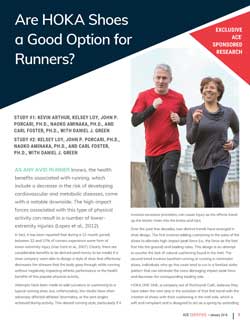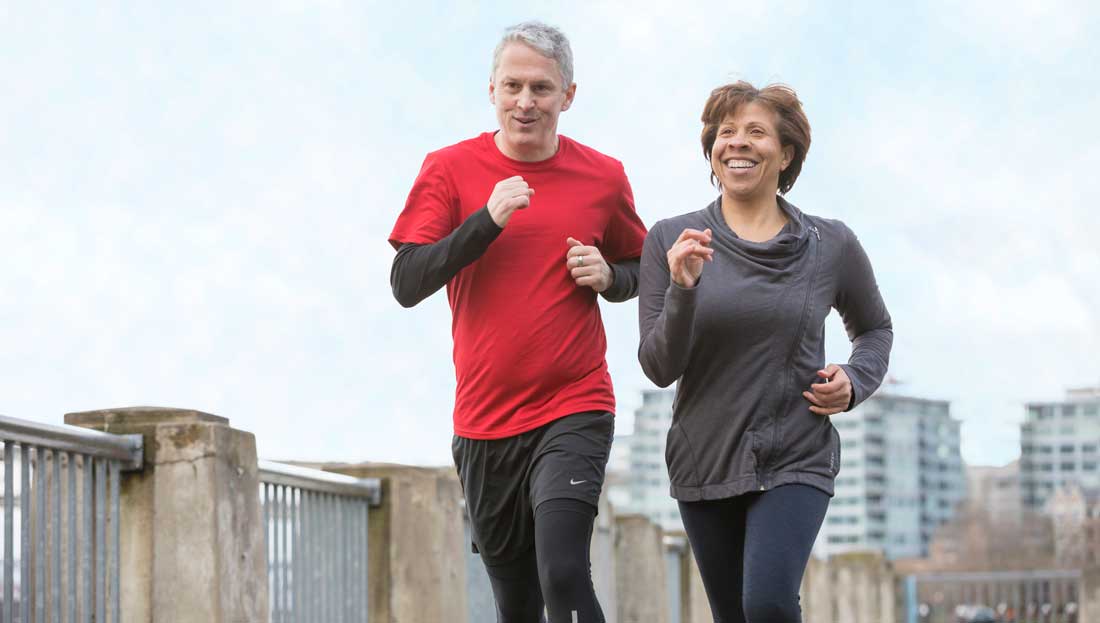
Study #1: Kevin Arthur, Kelsey Loy, John P. Porcari, Ph.D., Naoko Aminaka, Ph.D., and Carl Foster, Ph.D., with Daniel J. Green
Study #2: Kelsey Loy, John P. Porcari, Ph.D., Naoko Aminaka, Ph.D., and Carl Foster, Ph.D., with Daniel J. Green
As any avid runner knows, the health benefits associated with running, which include a decrease in the risk of developing cardiovascular and metabolic diseases, come with a notable downside. The high-impact forces associated with this type of physical activity can result in a number of lower-extremity injuries (Lopes et al., 2012). In fact, it has been reported that during a 12-month period, between 32 and 57% of runners experience some form of lower-extremity injury (Van Gent et al., 2007). Clearly, there are considerable benefits to be derived (and money to be made) if a shoe company were able to design a style of shoe that effectively decreases the stresses that the body goes through while running without negatively impacting athletic performance or the health benefits of this popular physical activity.
Attempts have been made to add curvature or cushioning to a typical running shoe, but, unfortunately, the results have often adversely affected athletes’ kinematics, or the joint angles achieved during activity. This altered running style, particularly if it involves excessive pronation, can cause injury as the effects travel up the kinetic chain into the knees and hips.
Over the past few decades, two distinct trends have emerged in shoe design. The first involves adding cushioning to the soles of the shoes to alleviate high-impact peak force (i.e., the force as the foot first hits the ground) and loading rates. This design is an attempt to counter the lack of natural cushioning found in the heel. The second trend involves barefoot running or running in minimalist shoes. Individuals who go this route tend to run in a forefoot strike pattern that can eliminate the more damaging impact peak force and decrease the corresponding loading rate.
HOKA ONE ONE, a company out of Goleta, Calif., believes they have taken the next step in the evolution of that first trend with the creation of shoes with thick cushioning in the mid-sole, which is soft and compliant and is designed to act as a spring by extending the time during which forces are applied, and a rocker bottom sole that they say lowers the ground reaction forces and improves running form.
The company claims that with 50% more material added to the sole, their shoes potentially allow for more shock absorption with each foot contact. However, this attribute results in the shoes being a bit heavier than typical running shoes, a change in design that could potentially slow runners down or alter their gait.
ACE enlisted the help of John Porcari, Ph.D., and his team of researchers in the Department of Exercise Sport Science at the University of Wisconsin–La Crosse to examine the HOKA shoes. They conducted two distinct studies, the first looking at the effect of HOKA shoes on running speed, as well as running mechanics and resultant forces, and the second exploring whether the shoes alter the energy cost of running when compared to a standard running shoe.
Study #1: Biomechanics and Speed
For this study, Dr. Porcari and his team recruited eight male and eight female volunteers who ran at least 6 miles per week and had not experienced a lower-extremity injury within the three months prior to testing (Table 1). None of the runners had worn HOKA shoes prior to the study.
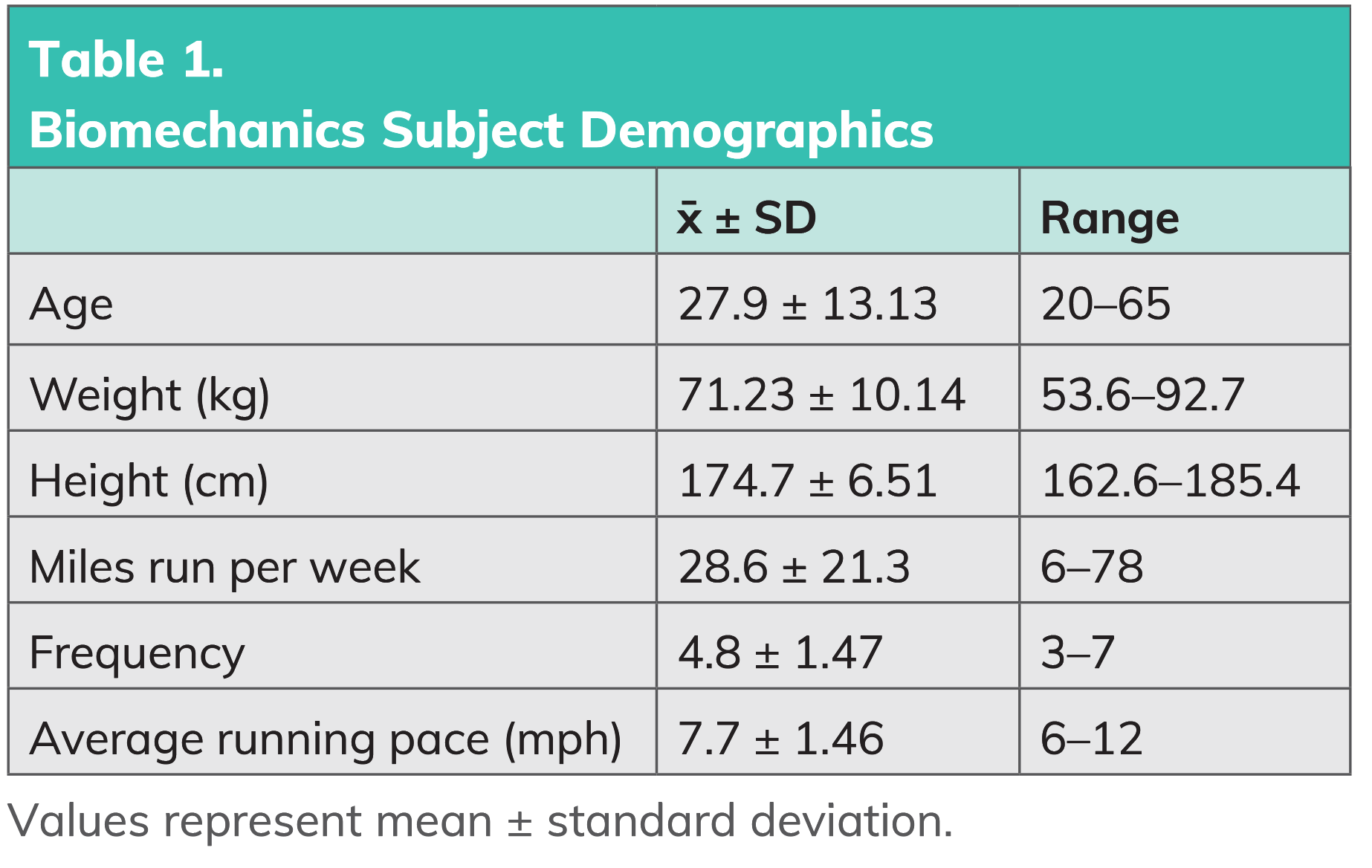
The subjects attended one testing session and completed two separate running conditions, in random order: running in the HOKA shoes and running in New Balance shoes. To measure joint angles, subjects had retroflective markers placed at specific locations on the body (Figures 1a and b), and three-dimensional motion-capture cameras were used to record them as they ran. Measurements were made on both legs in each shoe condition. The analysis looked at the differences in knee flexion (as degrees less than 180° in the sagittal plane), dorsiflexion (in degrees less than 90° of the foot and lower leg) and foot inversion (measured in degrees beyond 0° of the foot and shin in the frontal plane) during initial contact and at the time of active peak.
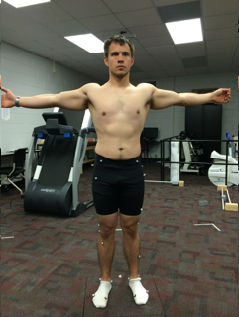
Figure 1a. Anterior view of retroflective markers placed at the 1st metatarsal head, 5th metatarsal head, calcaneal tuberosity, lateral malleolus, medial malleolus, mid-tibia (shank), lateral knee joint line, mid-femur (thigh), greater trochanter of the femur, anterior superior iliac spine, posterior superior iliac spine and sacrum
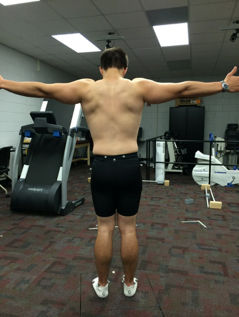
Figure 1b. Posterior view of retroflective markers placed at the 1st metatarsal head, 5th metatarsal head, calcaneal tuberosity, lateral malleolus, medial malleolus, mid-tibia (shank), lateral knee joint line, mid-femur (thigh), greater trochanter of the femur, anterior superior iliac spine, posterior superior iliac spine and sacrum
Force plates were used to collect data on impact peak (IP), loading rate (LR) and active peak (AP) (Figure 2).
IP = The maximal force applied during initial foot contact
LR = IP/time
AP = The maximal force at mid-stance
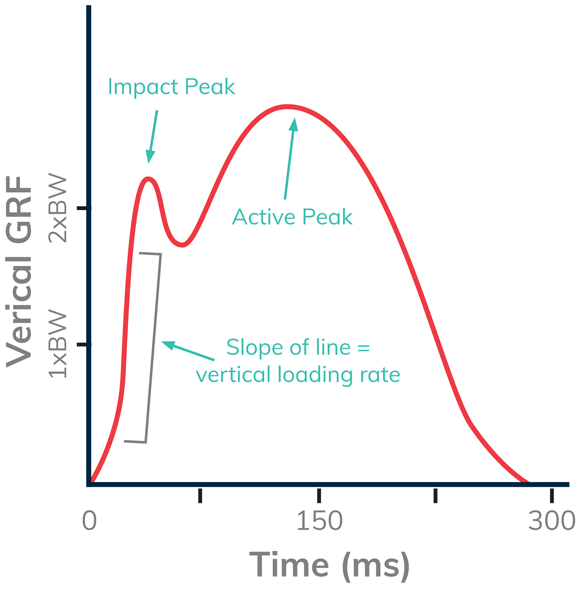
Figure 2. Depiction of a ground reaction forces graph, including the loading rate, impact peak and active peak
The Results of Study #1
There was no significant difference in average running speed—the participants ran at a self-selected pace in all trials—when the subjects wore the two different types of shoes. Running in HOKA shoes resulted in a significantly higher IP (about 4.5 percent higher), but there were no significant differences in either AP or LR. Finally, there were no significant differences between shoes in terms of knee flexion, dorsiflexion or foot inversion at either initial contact or mid-stance.
The only significant difference found in this research was the 4.5% overall higher IP when wearing the HOKA shoe than when wearing typical running shoes. Although this higher IP might suggest increased injury risk for the runner, Dr. Porcari speculates that the increased surface area in the midsole and rocker bottom may mitigate this risk.
Study #2: Energy Cost
For this study, 16 proficient runners (eight males and eight females) were recruited to participate (Table 2). All subjects ran at least 15 miles per week and were accustomed to running on a treadmill. They attended one testing session that consisted of running for six minutes under each of three running conditions: wearing HOKA shoes, wearing New Balance Running Course shoes and wearing the New Balance shoes with weight added to match that of the HOKA shoes. Each trial was conducted at the same speed and in random order.

Throughout each trial, oxygen uptake (VO2) was measured continuously, while heart rate (HR) was recorded each minute and ratings of perceived exertion (RPE) were assessed at the end of each run using the 6-to-20 scale. Energy expenditure (kcal) was calculated from the VO2 data.
It is important to note that with 50% more material added to the sole of the HOKA shoes, there is the potential to allow for more shock absorption with each foot contact. However, this attribute adds weight to the lower extremities, and research has shown that every 100 grams of weight added to each foot during running raises the energy cost by approximately 1% (Frederick, 1985). The question researchers sought to answer is whether or not the HOKA shoes would drive an unwanted increase in energy cost.
The Results of Study #2
The overall responses to each of the shoe conditions are presented in Table 3. No significant differences were observed in VO2, HR or kcal among the three shoe conditions. There were also no differences in RPE.
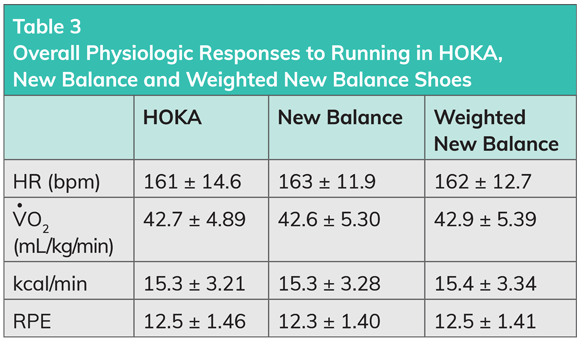
The Bottom Line
This research is an example of that rare study where a lack of significant findings is a positive outcome. Dr. Porcari reminds us that adding curvature and weight, as is seen with this type of shoe design, has typically led to changes in runners’ kinematics, meaning that the shoes adversely affected running form and opened athletes up to the potential for increased injury risk. The lack of increase in energy cost seen when subjects were wearing the HOKA shoes may be attributable to the fact that the average weight difference between the HOKA shoes and the New Balance running shoes was only 72.2 grams, which would account for a less than 1% increase in energy cost (Frederick, 1985).
“The lack of a difference in biomechanics seen in our research is a good thing,” explains Dr. Porcari. “Any time you change the height, weight or curvature of footwear, you run the risk of throwing off a person’s biomechanics.”
This study also did not reveal any issues with running speed or efficiency, which means that the HOKA shoes appear to be a quality option for runners. They may not provide tremendous benefits, at least in this short-term study, but they also do not create any detriment, and it’s hard to overstate the importance of that result.
So why wear the HOKA shoes? “It’s really a matter of comfort,” says Dr. Porcari. “From a performance view, there was not much of a difference revealed in our studies, but the HOKA shoes are good, comfortable shoes.”
According to Dr. Porcari, the next step for evaluating the HOKA shoes would be a longer-term study that looks at how wearing these shoes translates to real-world performance among long-distance runners, such as marathoners and ultra-marathoners, who make up the company’s target market.
References
Frederick, E. (1985). The energy cost of load carriage on the feet during running. In: Winter, D.A. et al. (Eds.). Biomechanics IX: Part B. Champaign, Ill.: Human Kinetics, pp. 295–300.
Lopes, A.D. et al. (2012). What are the main running-related musculoskeletal injuries? Sports Medicine, 42, 10, 891–905.
Van Gent, R.N. et al. (2007). Incidence and determinants of lower extremity running injuries in long distance runners: A systematic review. British Journal of Sports Medicine, 41, 8, 469–480.





 by
by 

